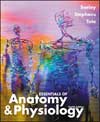 |  Essentials of Anatomy & Physiology, 4/e Rod R. Seeley,
Idaho State University
Philip Tate,
Phoenix College
Trent D. Stephens,
Idaho State University
The Chemistry of Life
Study OutlineBasic Chemistry
Matter, Mass, and Weight
Elements and Atoms(Table 2.1, p. 21)Atomic Structure(Fig. 2.1, p.21 and Fig. 2.2, p. 22)Nucleus
Protons (+)Neutrons (neutral) Atomic numberClinical Focus: Clinical Applications
of AtomicOrbitalsParticles, p. 26
Electrons (-) Electrons and Chemical Bonding
Ionic bonding(Fig. 2.3, p. 22, Table 2.2, p. 23)Covalent bonding(Fig. 2.4, p. 23)Single
Double
Polar(Fig. 2.5, p. 24) Hydrogen bonds(Fig. 2.6, p. 24) Molecules and Compounds
Dissociation(Fig. 2.7, p. 25) Chemical Reactions
Classification of Chemical Reactions
Synthesis reactions
Decomposition reactions
Exchange reactions
Reversible Reactions-equilibrium
Energy and Chemical Reactions(Fig. 2.8, p. 28)Rate of Chemical Reactions
Reactants
Concentration
Temperature of reactants
Catalysts-enzymes
Acids and Bases
The pH scale(Fig. 2.9, p. 29) Neutral solution
Acidic solution
Alkaline, or Basic solution Salts
Buffers(Fig. 2.10, p. 30) Inorganic Chemistry
Oxygen and Carbon Dioxide
Water
Properties
Stabilizes body temperature-absorbs heat
Protection-lubricant
Chemical reactions
Transport-dissolve in water
Organic Chemistry (Table 2.3, p. 31)Carbohydrates(Fig. 2.11, p. 32)Monosaccharides
Disaccharides
Polysaccharides
Lipids(Fig. 2.12, p. 33)Fats (Triacylglycerols)(Fig. 2.13, p. 33)Saturated
Unsaturated
Phospholipids
Steroids
Proteins(Fig. 2.14, p. 35)Amino acids
Denaturation
Enzymes
Activation energy(Fig. 2.15, p. 36)Lock and key model(Fig. 2.16, p. 36) Nucleic acids
DNA(Fig. 2.17, p. 37)RNA
|
|



 2002 McGraw-Hill Higher Education
2002 McGraw-Hill Higher Education